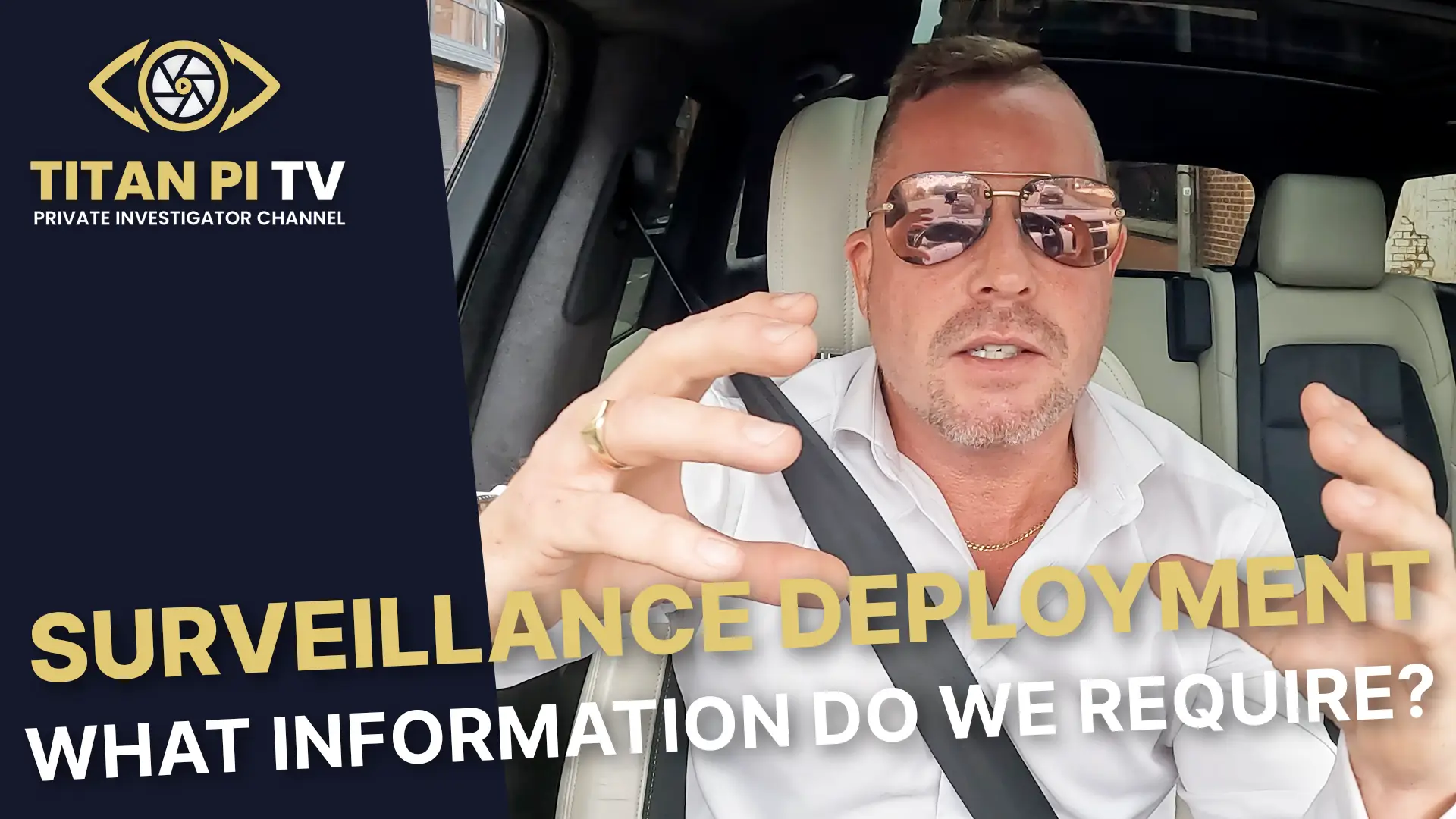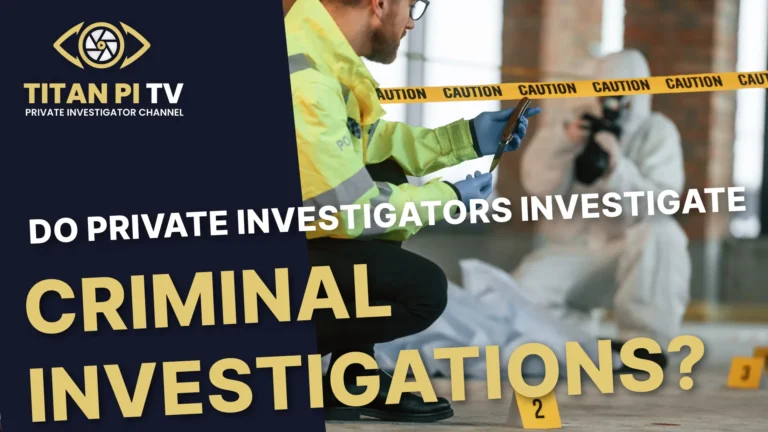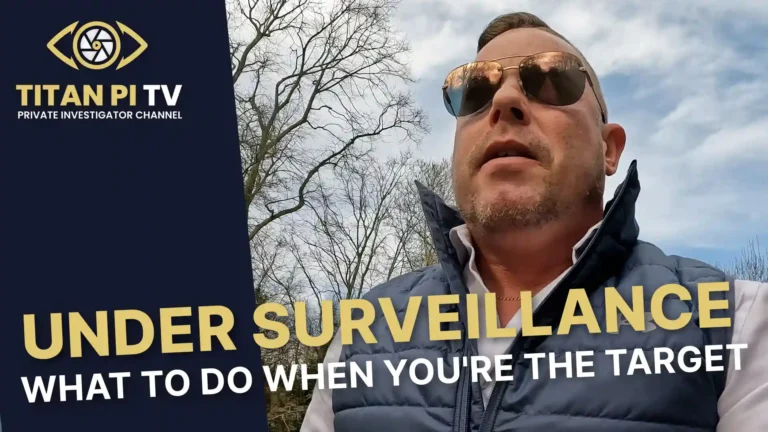Surveillance Deployment: What information is required?
The Essential Information Required for Surveillance Deployement
In the latest episode of Titan PI TV, Simon Henson, Managing Director of Titan Private Investigation Limited, offers viewers a rare glimpse into the meticulous planning and information gathering that underpins every successful surveillance deployment. As the host of the channel and a seasoned investigator, Simon’s expertise shines through as he breaks down the critical elements required before any operation can commence, ensuring both effectiveness and legality.
The World of Private Investigation: Behind the Scenes
Titan PI TV has become a trusted source for those interested in the realities of private investigation, demystifying the processes that often remain hidden from public view. In this episode, Simon Henson welcomes viewers into the heart of Titan’s operations in Derby, setting the stage for a detailed exploration of what it truly takes to prepare for a surveillance deployment.
“Welcome and happy Friday,” Henson begins, his tone both professional and approachable. He reminds viewers that Titan PI TV is available as a podcast for those who prefer to listen on the go, underscoring the agency’s commitment to accessibility and transparency.
The Decision to Deploy Surveillance
The episode’s focus is clear from the outset: once a client has decided to instruct a surveillance deployment, what information must be provided to ensure the operation’s success? Simon distils this into five essential categories, each of which plays a pivotal role in the planning and execution of surveillance.
The Five Pillars of Surveillance Preparation
1. Subject Details
At the core of any surveillance operation is the subject – the individual whose activities are to be observed. Ideally, investigators require the subject’s full name, date of birth, or at least an approximate age. However, Henson acknowledges that in some cases, the objective may be to identify an unknown individual, in which case such details may not be immediately available. “If that information is available, we would require it,” he notes, but flexibility is key in the world of investigations.
2. Start Location
A successful surveillance operation hinges on knowing where to begin. Whether it’s a home address, workplace, or another regular location, having a reliable starting point is crucial. Henson explains that sometimes, technology such as vehicle trackers can assist in establishing patterns, allowing investigators to predict where a subject will be at a given time. Regardless of the method, a clear start location is non-negotiable.
3. Image or Description of the Subject
Visual identification is paramount. “If you have an image of the subject, we require it,” Henson states unequivocally. In the absence of a photograph, a detailed physical description becomes essential. This ensures that operatives can positively identify the subject and maintain covert observation throughout the deployment. In some cases, the very aim of the operation may be to obtain high-quality imagery of the individual in question.
4. Associated Vehicles
Understanding how a subject moves is vital. If the individual uses specific vehicles, details such as make, model, colour, and registration numbers are invaluable. Henson points out that sometimes, new vehicles come to light during the operation, or the subject may rely on public transport. “We need to know how they’re going to be mobilised,” he says, emphasising the importance of adaptability and thoroughness.
5. Known Itinerary
Finally, any information about the subject’s planned movements or schedule can dramatically enhance the effectiveness of surveillance. “Rather than it be a guessing game, so that we can put tactics in place,” Henson explains, “give us that itinerary beforehand.” Whether it’s a routine school run, a business meeting, or a visit to a particular location of interest, foreknowledge allows the team to plan and execute with precision.
Flexibility and Professionalism
While these five categories represent the ideal, Simon is quick to reassure clients that operations can proceed with less information if necessary. “We can work with less than that in certain situations,” he says, highlighting the adaptability that is often required in the field.
The Legal Foundation: Legitimate Interest Assessment
Before any operational planning begins, Titan Private Investigation ensures that a legitimate interest assessment has been completed. This legal safeguard confirms that the surveillance is justified and compliant with relevant laws, including data protection regulations. “That’s the lawful side of it,” Simon affirms, underscoring the agency’s commitment to ethical practice.
The Operational Order: Blueprint for Success
With the necessary information in hand and legal checks complete, attention turns to the operational order – the comprehensive briefing document that guides the surveillance team. Simon introduces viewers to the mnemonic “I, I MARCH,” a structured approach that encapsulates all aspects of the operation:
- Information: All intelligence gathered from the client, including the five key points outlined earlier.
- Intention: The objective of the operation – what the team is there to achieve, and the parameters within which they must operate.
- Method: The tactics and strategies to be employed, including rendezvous points, reconnaissance (or “rekki”) reports, and allocation of responsibilities among team members.
- Admin: Logistical details such as call signs, operative vehicle details, contact numbers, and required equipment.
- Risk Assessment: A thorough evaluation of potential hazards, including the subject’s awareness of surveillance, previous incidents of compromise, and emergency procedures.
- Communication: The channels and protocols for team communication, including contingencies for equipment failure.
- Human Rights: Ensuring compliance with the Information Commissioner’s Office guidelines, GDPR, and minimising collateral intrusion – the inadvertent collection of information about individuals not relevant to the investigation.
Delving Deeper: The I, I MARCH Framework
Information forms the backbone of the operation, encompassing everything known about the subject, their habits, and the context of the investigation. This intelligence is shared securely with the team, ensuring everyone is fully briefed.
Intention clarifies the mission’s purpose, setting clear boundaries and objectives. This prevents “mission creep” and ensures that all actions remain focused and justified.
Method covers the practicalities: how the surveillance will be conducted, which tactics will be used, and how the team will respond to various scenarios. Henson highlights the importance of reconnaissance, particularly when starting at unfamiliar locations such as hotels. Knowing all exit points, reception areas, and potential escape routes allows the team to operate efficiently and discreetly.
Admin ensures that all logistical details are in place. From vehicle assignments to equipment checklists, this section leaves nothing to chance.
Risk Assessment is a critical component, with Simon noting that he could dedicate an entire episode to the subject. Every deployment is assessed for foreseeable hazards, from the subject’s potential surveillance awareness to the location of nearby hospitals and emergency rendezvous points.
Communication protocols are established to maintain operational integrity. Whether using radios or mobile phones, the team must be prepared for technical failures and have backup plans in place.
Human Rights considerations are woven throughout the process. Simon is clear: “Are we sticking to GDPR, making sure our evidential footage is gained lawfully?” The operational order may include specific instructions to avoid recording individuals not relevant to the investigation, thereby minimising collateral intrusion and protecting privacy.
The Importance of Professionalism and Compliance
Throughout the episode, Simon’s emphasis on professionalism, legality, and ethical conduct is unmistakable. Surveillance is not a game of chance; it is a carefully orchestrated process that demands attention to detail, respect for the law, and a commitment to protecting the rights of all individuals involved.
By sharing these insights, Titan PI TV not only educates its audience but also sets a benchmark for best practice within the industry. Clients can be assured that their cases are handled with the utmost care, from initial instruction to the final report.
Final Thoughts: Knowledge is Power
We encourage viewers to engage with the channel, reminding them to “give us a thumbs up” and subscribe for future episodes. His closing words encapsulate the ethos of Titan Private Investigation: “Thanks for listening.”
For anyone considering instructing a surveillance deployment, or simply curious about the inner workings of private investigation, this episode of Titan PI TV offers invaluable guidance. By understanding the information required and the processes involved, clients and viewers alike gain a deeper appreciation for the skill, dedication, and integrity that define the profession.
Subscribe to Titan PI TV on YouTube or download the podcast to stay informed about the latest developments in private investigation.
What’s Next on Titan PI TV?
Thank you for reading, watching or listening to this week’s blog post on Titan PI TV. If you found this information helpful, please give us a thumbs up and subscribe to our channel. Stay tuned for more insights into the world of private investigations. Until next time, stay safe and keep learning!
Titan PI TV: Uncovering the Truth, One Investigation at a Time.




















